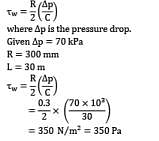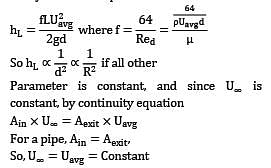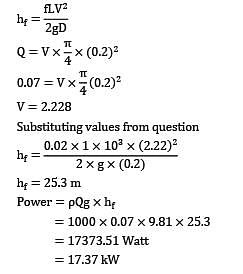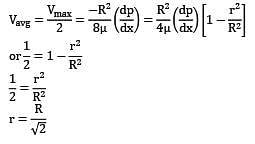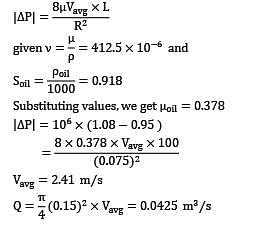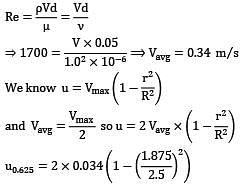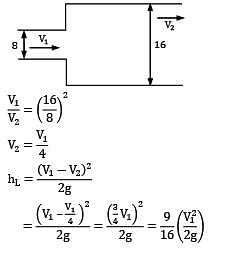Test: Viscous Flow of Incompressible Fluids, Flow Losses Level - 1 - Mechanical Engineering MCQ
20 Questions MCQ Test Fluid Mechanics for Mechanical Engineering - Test: Viscous Flow of Incompressible Fluids, Flow Losses Level - 1
The pressure drop for a flow with relatively low Reynolds number through a 600 mm diameter, 30 m long pipeline is 70 kPa. What is the wall shear stress?
For a pipe of circular cross section, assuming Darcy Weisbach equation holds and free stream velocity is constant
| 1 Crore+ students have signed up on EduRev. Have you? Download the App |
Find the loss of head due to friction in a smooth pipe of rectangular cross section of 1 m × 0.5 m and 10 m long. Velocity of flow is 10 m⁄s and the friction coefficient is 0.01962.
The purpose of surge tank in a pipe line is to
Head loss in turbulent flow in a pipe
Oil at 20°C (ρ = 888 kg⁄m3 and μ = 0.800 kg/m ∙ s) is flowing steadily through a 5 cm diameter, 40 m long pipe. The pressure at the pipe inlet and outlet are measured to be 745 and 97 kPa, respectively. Determine the flow rate of oil (in L/s) through the pipe assuming the pipe is horizontal.
Water at 25°C is flowing through a 1.0 km long GI pipe of 200 mm diameter at the rate of 0.07 m3⁄s. If value of Darcy friction factor for this pipe is 0.02 and density of water is 1000 kg/m3, the pumping power (in kW) required to maintain the flow is
Pipes of lengths l1 , l2 etc. and diameters d1 , d2 , etc., are connected in series. A single pipe of length l1 + l2 + l3 +……having same pressure loss as all pipes in series will have diameter equal to
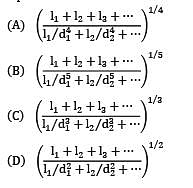
The velocity distribution for a fully-developed laminar flow in a pipe is given by

Determine the radial distance from the pipe axis at which the velocity equals the average velocity.
Heavy fuel oil flows from A to B through a 100 m horizontal steel pipe of 150 mm diameter. The pressure at A is 1.08 MPa and at B is 0.95 MPa. The kinematic viscosity is 412.5 × 10−6 m2⁄s, and the relative density of the oil is 0.918. What is the flow rate in m3⁄s?
In the case of fully developed flow through tubes
The Reynolds number for flow of oil through a 5 cm diameter pipe is 1700. The kinematic viscosity, v = 1.02 × 10−6 m2⁄s. What is the velocity at a point 0.625 cm away from the wall?
Three identical pipes of length l, diameter d and friction factor f are connected in parallel between two reservoirs. What is the size of a pipe of length l and of the same friction factor f equivalent to the above pipe?
The extent of pressure produced due to water hammer depends on
The head loss in a sudden expansion from 8 cm diameter pipe to 16 cm diameter pipe in terms of velocity V1 in the smaller pipes is

Flow takes place at Reynolds number of 1500 in two different pipes with relative roughness of 0.001 and 0.002. The friction factor
For laminar flow through a round pipe, the shear stress
Laminar flow between closely spaced parallel, stationary plates is governed by the consideration of which one of the following pair of forces?
Which one of the following statements is not correct in the context of laminar flow through a pipeline?
The center-line velocity in a flow between parallel plates is 3 m⁄s. What is the average flow velocity between the plates if the Reynolds number of the flow is 800?
|
56 videos|104 docs|75 tests
|
|
56 videos|104 docs|75 tests
|


